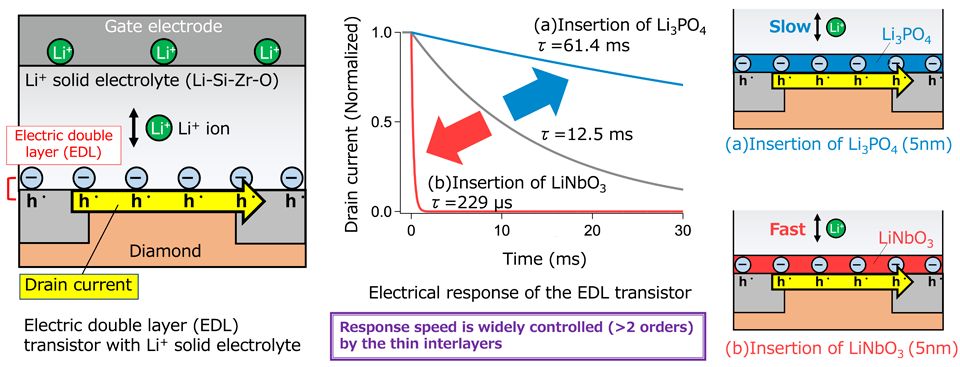It is vital to develop all-solid-state batteries to accomplish carbon neutrality. However, because of their high surface resistance, these batteries have low output, restricting their applications.

TUS researchers demonstrate unprecedented control over response speed for next-generation all-solid-state batteries. Investigating the EDL effect at the solid electrolyte interface by a novel technique, researchers tuned switching response time and achieved carrier modulation at the interface between a hydrogen-terminated diamond (H-diamond) and a Li+-conducting solid electrolyte/solid interface. Image Credit: Tohru Higuchi from Tokyo University of Science
Investigators used a new technique to examine and fine-tune electric double-layer dynamics at the solid/solid electrolyte interface. Researchers demonstrated a greater degree of control of response speed by more than two orders of magnitude, which is a significant step toward the commercialization of all-solid-state batteries.
All-solid-state lithium-ion batteries (ASS-LIBs) hold a lot of promise in the quest for clean energy and carbon neutrality. ASS-LIBs will be used in a variety of applications, including electric vehicles (EVs). However, commercial applications of these batteries are currently experiencing a bottleneck because of their high surface resistance.
Furthermore, the precise mechanism of this surface resistance is uncertain. Scientists have associated it with a phenomenon known as the “electric double layer” (EDL) effect, which is observed in colloidal substances (which are microscopic dispersions of one kind of particle in another substance). When colloidal particles adsorb negatively charged ions from the dispersion medium on their surface, they undergo the EDL effect.
This occurs at the solid/solid electrolyte interface, posing a problem in all-solid-state lithium batteries.
Dr Tohru Higuchi, Associate Professor, Tokyo University of Science
Dr. Higuchi developed an innovative technique to quantitatively evaluate the EDL impact at the solid/solid electrolyte interface with co-workers Dr Makoto Takayanagi from TUS and Dr Takashi Tsuchiya and Dr Kazuya Terabe from Japan’s National Institute for Materials Science.
On February 8th, 2023, the research was published in the journal Materials Today Physics. The researchers conducted Hall measurements and pulse response measurements on an all-solid-state hydrogen-terminated diamond (H-diamond)-based EDL transistor (EDLT) to evaluate EDL charging characteristics.
The group could examine the electrical response of the EDL effect at the interface between these two layers by incorporating a nanometer-thick lithium niobate or lithium phosphate interlayer between the H-diamond and lithium solid electrolyte. The composition of the electrolyte did, in fact, impact the EDL effect in a small region all around the electrode interface.
When a specific electrolyte was introduced as an interlayer between the electrode/solid electrolyte interface, the EDL effect was lowered. The lithium phosphate/H-diamond interface had much higher EDL capacitance than the lithium niobate/H-diamond interface.
The study also details how they advanced the switching response time for charging ASS-EDLs.
The EDL has been shown to influence switching properties, so we considered that the switching response time for charging ASS-EDLs could be greatly improved by controlling the capacitance of the EDL. We used the non-ion-permeable property of diamond in the electron layer of the field-effect transistor and combined it with various lithium conductors.
Dr. Tohru Higuchi, Associate Professor, Tokyo University of Science
The EDL charging speed was accelerated and decelerated by the interlayer. The EDLT's electrical response time was extremely variable, ranging from approximately 60 milliseconds (low-speed switching for lithium phosphate/H-diamond interface) to approximately 230 microseconds (high-speed switching for lithium niobate/H-diamond interface).
The group demonstrated control over the EDL charging speed by more than two orders of magnitude.
The investigators were capable of achieving carrier modulation and enhancing the charging characteristics of all-solid-state devices.
These results from our research on the lithium-ion conductive layer are important for improving the interface resistance and may lead to the realization of all solid-state batteries with excellent charge-discharge characteristics in the future.
Dr. Tohru Higuchi, Associate Professor, Tokyo University of Science
This is a significant step toward modifying the interface resistance of ASS-LIBs, which catalyzes their viability for a wide range of applications. It will also aid in the development of better solid-electrolyte-based devices, which include neuromorphic devices.
Journal Reference
Takayanagi, M., et al. (2023) Accelerated/decelerated dynamics of the electric double layer at hydrogen-terminated diamond/Li+ solid electrolyte interface. Materials Today Physics. doi.org/10.1016/j.mtphys.2023.101006.